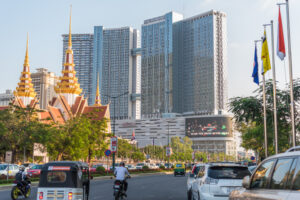Cambodia is a Southeast Asian country with a population of about 16.7 million people and a GDP of about $30.7 billion. The country has been one of the fastest-growing economies in the world, with an average growth rate of 8% between 1998 and 2018. However, the Covid-19 pandemic has severely affected the economy, causing a contraction of 3.1% in 2020 and a modest recovery of 3% in 2021.
According to various sources(english.cambodiadaily.com)(adb.org)(adb.org)(information.gov.kh)(channelnewsasia.com), Cambodia’s economy is expected to grow by 5% in 2022 and 5.4% in 2023, supported by strong merchandise exports and foreign direct investment inflows. The main drivers of growth are expected to be:
• Industry: The industrial sector is projected to grow by 8.1% in 2022 and 9.1% in 2023, mainly due to the expansion of the garment, footwear, and travel goods industry, which accounts for about 80% of the country’s exports. The government has implemented a Garments, Footwear, and Travel Goods Development Strategy to enhance the competitiveness and diversification of this sector. Other industries, such as bicycles, electronic components, wiring products, and renewable energy, are also expected to grow as the country diversifies its economy.
• Services: The services sector is projected to rebound to 4.8% in 2022 and 6.8% in 2023, driven by the gradual recovery of tourism, which is one of the main sources of income and employment for the country. The government has reopened the borders for vaccinated tourists and has launched various initiatives to promote domestic tourism and improve the quality and safety of tourism services. Other services, such as accommodation, food, transportation, telecommunications, and finance, are also expected to benefit from the reopening of the economy and the high level of vaccination coverage.
• Agriculture: The agricultural sector is projected to grow by 1.9% in 2022 and 2% in 2023, supported by favorable weather conditions and increased demand for agricultural products, especially rice, cassava, rubber, and cashew nuts. The government has implemented various policies and programs to improve the productivity, quality, and market access of agricultural products, such as providing seeds, fertilizers, irrigation systems, credit facilities, extension services, and infrastructure.
The main challenges and risks for Cambodia’s economy in 2023 are:
• External demand shocks: Cambodia’s economy is highly dependent on external demand for its exports, especially from the US and the EU, which account for about two-thirds of its total exports. Any slowdown or disruption in these markets due to the Covid-19 pandemic or other factors could adversely affect Cambodia’s export performance and growth prospects.
• Domestic Covid-19 outbreaks: Cambodia has successfully contained the Covid-19 pandemic so far, with low infection and mortality rates and high vaccination coverage. However, there is still a risk of new variants or outbreaks that could undermine the public health situation and the economic recovery. The government needs to maintain vigilance and preparedness to prevent and respond to any potential health emergencies.
• Structural constraints: Cambodia faces various structural constraints that limit its long-term growth potential and competitiveness, such as weak rule of law, poor infrastructure, high energy costs, under-developed human resources, political stability issues, and environmental challenges. The government needs to address these constraints through comprehensive reforms and investments that can enhance the business environment, diversify the economy, improve the quality of public services, strengthen governance and institutions, protect human rights and social inclusion, and promote green growth.
In conclusion, Cambodia’s economy is expected to grow by 5% in 2022 and 5.4% in 2023, supported by strong merchandise exports and foreign direct investment inflows. However, the economy faces various challenges and risks that require continued policy support and structural reforms to ensure a sustainable and inclusive recovery.
